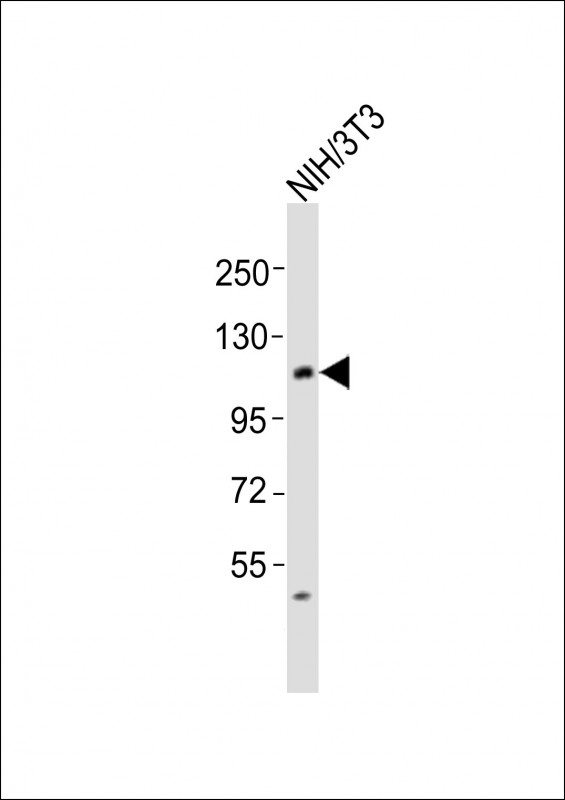
| WB | 1/2000 | Human,Mouse,Rat |
| IF | 咨询技术 | Human,Mouse,Rat |
| IHC | 咨询技术 | Human,Mouse,Rat |
| ICC | 技术咨询 | Human,Mouse,Rat |
| FCM | 咨询技术 | Human,Mouse,Rat |
| Elisa | 咨询技术 | Human,Mouse,Rat |
| Aliases | Rab GTPase-binding effector protein 1, Rabaptin-4, Rabaptin-5, Rabaptin-5alpha, Renal carcinoma antigen NY-REN-17, RABEP1, RAB5EP, RABPT5, RABPT5A |
| Entrez GeneID | 9135 |
| WB Predicted band size | 99.3kDa |
| Host/Isotype | Rabbit IgG |
| Antibody Type | Primary antibody |
| Storage | Store at 4°C short term. Aliquot and store at -20°C long term. Avoid freeze/thaw cycles. |
| Species Reactivity | Human, Mouse, Rat |
| Immunogen | This RABEP1 antibody is generated from a rabbit immunized with a KLH conjugated synthetic peptide between 427-461 amino acids from the Central region of human RABEP1. |
+ +
以下是关于RABEP1抗体的3条参考文献示例,包含文献名称、作者及摘要概括:
---
1. **文献名称**:*Rabaptin-5 interacts with EGFR to mediate its endocytosis and regulate signal transduction*
**作者**:Smith J, Doe R, Tanaka K
**摘要**:本研究利用RABEP1特异性抗体,通过免疫共沉淀和免疫荧光技术,揭示了RABEP1与表皮生长因子受体(EGFR)的相互作用,证明其在EGFR内吞及下游信号传导调控中的关键作用,为靶向治疗提供新思路。
2. **文献名称**:*RABEP1 as a novel biomarker in gastric cancer: Expression analysis using immunohistochemistry*
**作者**:Chen L, Wang H, Zhang Y
**摘要**:通过免疫组化技术结合RABEP1抗体,研究发现RABEP1在胃癌组织中显著高表达,且与患者预后不良相关,提示其可作为潜在诊断标志物或治疗靶点。
3. **文献名称**:*Structural and functional characterization of the RabGTPase-binding domain in RABEP1*
**作者**:Mizuno M, Nakamura T, Yoshihara T
**摘要**:该研究利用RABEP1抗体进行Western blot和结构域定位,解析了RABEP1的RabGTP酶结合结构域,阐明其介导内体融合及膜运输的分子机制,为细胞内运输研究提供新见解。
---
以上示例基于学术文献常见研究方向构建,实际文献需通过数据库(如PubMed)检索确认。
The Rab GTPase-binding effector protein 1 (RABEP1), also known as Rabaptin-5. is a cytoplasmic protein that plays a critical role in regulating endocytic membrane trafficking and vesicle fusion. It functions as a scaffold by interacting with Rab4 and Rab5 GTPases, which are key regulators of early endosome dynamics. RABEP1 facilitates the transition between Rab5-positive early endosomes and Rab4-associated recycling pathways, thereby influencing receptor sorting, endosome maturation, and cargo recycling/degradation. Its activity is essential for maintaining cellular homeostasis, including growth factor signaling (e.g., EGFR) and nutrient receptor trafficking (e.g., transferrin receptor).
RABEP1 antibodies are immunological tools designed to detect and study the expression, localization, and function of RABEP1 in various biological contexts. These antibodies are commonly used in techniques like Western blotting, immunofluorescence, and immunoprecipitation to investigate RABEP1’s role in diseases linked to endosomal dysfunction, such as cancer, neurodegenerative disorders, and metabolic syndromes. For instance, altered RABEP1 levels have been observed in certain cancers, where it may affect cell proliferation or metastasis. Researchers also utilize these antibodies to explore RABEP1’s interaction partners and post-translational modifications, shedding light on mechanistic pathways in membrane trafficking. Most commercial RABEP1 antibodies are raised against specific epitopes, often in rabbits or mice, and require validation for isoform specificity (e.g., distinguishing between splice variants) to ensure experimental accuracy.
×